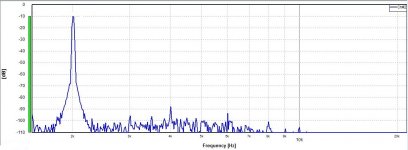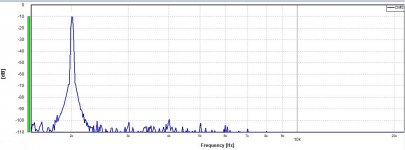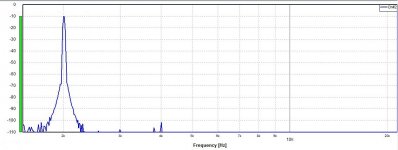Moved from another thread....
I have this dac (Bricasti M1) and I like it very much, but to my ears the treble (slightly) lacks ultimate resolution and sweetness compared with my other dacs. On bright and older recordings it can tend to be a little "unforgiving".
Taking a look at the pcbs's I noticed AD843 op-amps in the IV and buffer stages. These op-amps are not noted for audiophile qualities but they are advertised for high speed applications including 'high speed integration'.
In an effort to add some sweetness I decided to bias all of the op-amps into class A. I did this by adding a CRD with a series resistor from the op-amp output to the -ve rail. (4 per channel) I mounted them on the underside of the pcb so as not to deface the aesthetics. The resistor was used to set the v drop across the CRD to the mid point of the linear region, which for the specific 2mA CRD used was 8.5 vdc.
Because the op-amps are all paired from the diff outputs from the dac, I decided to batch test and match the CRD's to <1%, which was possible because I had a large stock on hand. I also found that the CRD's ranged in value from 1.7 to 2.3mA, but nominally 1.9mA.
I also tested the current sink regulation over a 3V range and it was a creditable 99.8%.
While I had the dac apart I also passed a cursory eye over the linear power supplies which are all discrete types using op-amps to generate references and with tip120/125 darlington output transistors.
I noticed that a 104 film cap had been installed across the bridge rectifier input (transformer secondaries) and another at the bridge output, but there was no series resistor with the input 104, so it obviously isn't an effective "snubber". This seemed odd, so I subsequently unsoldered one side and added a 330r resistor in series ( 2 per channel), though I didn't use the cro to check, from past experience those values are usually effective at damping any ringing.
OK, so how did it sound after this change you might ask?
Actually, I was very surprised to hear such a big change, because frankly, I wasn't able to measure anything substantial on the pc based analyzer. (distortion was already a low 0.001%)
However, the treble is now MUCH sweeter and more pristine than I could have ever imagined possible, and all of those bad old recordings are now very easy on the ear. It's now every bit the equal, and then some, of my Berkeley Alpha 2 in the treble and is easily the best overall and least 'digital' sounding of all my processors. I also now prefer to use the linear filter set rather than the minimum phase set.
It's worth noting though that I made two changes at the same time, so it's difficult to ascribe the contribution from each, but I'm assuming it's the 2mA of bias on all op-amps that's been the major factor.
I can't say that this same modification will be as effective for all op-amps, and / or in other implementations, but it's nonetheless worth experimenting with based on my personal experience.
I have this dac (Bricasti M1) and I like it very much, but to my ears the treble (slightly) lacks ultimate resolution and sweetness compared with my other dacs. On bright and older recordings it can tend to be a little "unforgiving".
Taking a look at the pcbs's I noticed AD843 op-amps in the IV and buffer stages. These op-amps are not noted for audiophile qualities but they are advertised for high speed applications including 'high speed integration'.
In an effort to add some sweetness I decided to bias all of the op-amps into class A. I did this by adding a CRD with a series resistor from the op-amp output to the -ve rail. (4 per channel) I mounted them on the underside of the pcb so as not to deface the aesthetics. The resistor was used to set the v drop across the CRD to the mid point of the linear region, which for the specific 2mA CRD used was 8.5 vdc.
Because the op-amps are all paired from the diff outputs from the dac, I decided to batch test and match the CRD's to <1%, which was possible because I had a large stock on hand. I also found that the CRD's ranged in value from 1.7 to 2.3mA, but nominally 1.9mA.
I also tested the current sink regulation over a 3V range and it was a creditable 99.8%.
While I had the dac apart I also passed a cursory eye over the linear power supplies which are all discrete types using op-amps to generate references and with tip120/125 darlington output transistors.
I noticed that a 104 film cap had been installed across the bridge rectifier input (transformer secondaries) and another at the bridge output, but there was no series resistor with the input 104, so it obviously isn't an effective "snubber". This seemed odd, so I subsequently unsoldered one side and added a 330r resistor in series ( 2 per channel), though I didn't use the cro to check, from past experience those values are usually effective at damping any ringing.
OK, so how did it sound after this change you might ask?
Actually, I was very surprised to hear such a big change, because frankly, I wasn't able to measure anything substantial on the pc based analyzer. (distortion was already a low 0.001%)
However, the treble is now MUCH sweeter and more pristine than I could have ever imagined possible, and all of those bad old recordings are now very easy on the ear. It's now every bit the equal, and then some, of my Berkeley Alpha 2 in the treble and is easily the best overall and least 'digital' sounding of all my processors. I also now prefer to use the linear filter set rather than the minimum phase set.
It's worth noting though that I made two changes at the same time, so it's difficult to ascribe the contribution from each, but I'm assuming it's the 2mA of bias on all op-amps that's been the major factor.
I can't say that this same modification will be as effective for all op-amps, and / or in other implementations, but it's nonetheless worth experimenting with based on my personal experience.
Last edited:
I'm interested in this modification as I've done similar on a multibit DAC's I/V stage. A couple of questions.
Is there a cap across the feedback resistor of the AD843? Also am I right in thinking you applied 4 CRDs per opamp output, or 4 in total?
The DS for the AD1955 says the output current's 8.6mA p-p so I'd guess you'd need 2 or maybe even 3 CRDs to ensure the OPS stays in classA at all times.
Is there a cap across the feedback resistor of the AD843? Also am I right in thinking you applied 4 CRDs per opamp output, or 4 in total?
The DS for the AD1955 says the output current's 8.6mA p-p so I'd guess you'd need 2 or maybe even 3 CRDs to ensure the OPS stays in classA at all times.
I'm interested in this modification as I've done similar on a multibit DAC's I/V stage. A couple of questions.
Is there a cap across the feedback resistor of the AD843? Also am I right in thinking you applied 4 CRDs per opamp output, or 4 in total?
The DS for the AD1955 says the output current's 8.6mA p-p so I'd guess you'd need 2 or maybe even 3 CRDs to ensure the OPS stays in classA at all times.
It's 4 CRD's in total. (1 per op-amp)
TBH, I'm not sure if there's a cap across the FB resistor, although I noted the advised 5pf from the datasheet. Next time I take off the kid I'll take a closer look through the magnifier.
WRT the 8.6mA spec, it's p-p so the output to each op-amp is actually half that value. Only if I'm volume attenuated by 6dB will I be guaranteed to be within the class A region (2mA), assuming the dac is outputting max current, so technically you're correct. However, I drive the power amp direct from the M1 DAC, and on average there's usually about 10dB of attenuation dialed in.
Thanks, makes sense.
Incidentally I'm using your experience reported here to explain on a new forum that there are things in digital audio which haven't shown up yet in the usual measurements but which nevertheless get heard. Getting pushback though on whether what you heard you really heard 🙂 The discussion's here - What is 'incompetent digital' ? | Page 8 | Audio Science Review Forum
Incidentally I'm using your experience reported here to explain on a new forum that there are things in digital audio which haven't shown up yet in the usual measurements but which nevertheless get heard. Getting pushback though on whether what you heard you really heard 🙂 The discussion's here - What is 'incompetent digital' ? | Page 8 | Audio Science Review Forum
Did you take measurements (REW) before and after?
And two, is that you in your avatar?
I tried to measure distortion but couldn't see any major change, but that's mostly because my sound card is a limiting factor.
And yes, that was me before the operation - that converted me into a middle aged, slightly overweight male whose hobbies now include hi-fi audio and amateur radio.
Last edited:
Thanks, makes sense.
Incidentally I'm using your experience reported here to explain on a new forum that there are things in digital audio which haven't shown up yet in the usual measurements but which nevertheless get heard. Getting pushback though on whether what you heard you really heard 🙂 The discussion's here - What is 'incompetent digital' ? | Page 8 | Audio Science Review Forum
OK, thanks, I'll follow the thread.
I'm taking the modified m1 to a Bricasti owners GTG in two weeks and it will be judged against a standard unit by a panel of impartial listeners.
Do post back on this thread when their impressions are in, I'll follow with interest.
Am I right in thinking the Bricasti's analog section is pretty much the same as for the BAD Alpha DAC? Are you considering a classA mod to that too?
Am I right in thinking the Bricasti's analog section is pretty much the same as for the BAD Alpha DAC? Are you considering a classA mod to that too?
The BAD Alpha uses the AD1955 and a similar analogue stage topology, but the op-amps have been defaced to remove the identifying part numbers.
The treble on the BADA sounds pristine as it is so I'm not inclined to modify it, but bear in mind that there are differences between the two such as a custom FPGA based reconstruction filter (Bricasti) and upsampling (BADA).
To my ears, the Bricasti imparts less of an identifying signature than the BAD, although that wasn't the case prior to the modification, though the signatures were very different in nature.
Of course all DACS exhibit some degree of audible coloration, but what I strive for is the elimination of identifying signatures. I find a similar thing with pre and power amplifiers too, though not as pronounced as with DAC's.
I also use a modified CARY 302 CDP, which uses a 1704k DAC chip followed by a AD844 IV stage - as per DIY user George Hi-Fi's modification.
The treble on the BADA sounds pristine as it is so I'm not inclined to modify it, but bear in mind that there are differences between the two such as a custom FPGA based reconstruction filter (Bricasti) and upsampling (BADA).
To my ears, the Bricasti imparts less of an identifying signature than the BAD, although that wasn't the case prior to the modification, though the signatures were very different in nature.
Of course all DACS exhibit some degree of audible coloration, but what I strive for is the elimination of identifying signatures. I find a similar thing with pre and power amplifiers too, though not as pronounced as with DAC's.
I also use a modified CARY 302 CDP, which uses a 1704k DAC chip followed by a AD844 IV stage - as per DIY user George Hi-Fi's modification.
Make of this what you will.
using my pc and sound card, fft analysis; 2kHz @ 0dBfs, 24/96, and sound card input attenuated by 10dB to avoid overload.
Three dacs tested under identical conditions.
1. Wyred4Sound DAC2DSDse
2. Berkeley Alpha2
3. Bricasti M1.
*Note: Sound Card THD is around 0.001%, which limits measurement resolution.
using my pc and sound card, fft analysis; 2kHz @ 0dBfs, 24/96, and sound card input attenuated by 10dB to avoid overload.
Three dacs tested under identical conditions.
1. Wyred4Sound DAC2DSDse
2. Berkeley Alpha2
3. Bricasti M1.
*Note: Sound Card THD is around 0.001%, which limits measurement resolution.
Attachments
Last edited:
The Bricasti shows significantly lower noise floor - is this before the classA biassing or after?
The Bricasti shows significantly lower noise floor - is this before the classA biassing or after?
After mods, yes.
Btw, the dac shootout happens on Saturday, so I'll give a full report.
Also, I'm sure to be asked to repeat the mod on another Bricasti, so I'll measure thd + n before and after.
Incidentally I recommended your mod (not using the CRDs though) to Cidious for his ESS DAC, his result is here - http://www.diyaudio.com/forums/digital-line-level/287077-diy-l-k-s-es9018-dac.html#post4659473
Looking forward to the shootout report.
Looking forward to the shootout report.
Incidentally I recommended your mod (not using the CRDs though) to Cidious for his ESS DAC, his result is here - http://www.diyaudio.com/forums/digital-line-level/287077-diy-l-k-s-es9018-dac.html#post4659473
Looking forward to the shootout report.
Thanks for that link. It definitely validates my own experience.
The Bricasti GTG went very well.
There were 3 Bricasti owners and a few others to provide unbiased opinions.
I wasn't surprised that the modified M1 was unanimously voted "best".
And not surprisingly, all Bricasti M1 attendees have asked me to replicate the modifications in their M1's.
The Hi-Fi system used for testing was comprised of: Gryphon Antileon Evo power amplifier and matching Pandora Preamp, PS Audio PWT, and Revel Ultima Salon2 speakers.
There were 3 Bricasti owners and a few others to provide unbiased opinions.
I wasn't surprised that the modified M1 was unanimously voted "best".
And not surprisingly, all Bricasti M1 attendees have asked me to replicate the modifications in their M1's.
The Hi-Fi system used for testing was comprised of: Gryphon Antileon Evo power amplifier and matching Pandora Preamp, PS Audio PWT, and Revel Ultima Salon2 speakers.
Great result - seeing as actions speak loudest the request for modifications by M1 owners says most.
Having classA-ified the AD843 how about any further opamps downstream? If there's an opamp-based balanced filter stage beyond the I/V I could suggest some mods to that next 😛
Having classA-ified the AD843 how about any further opamps downstream? If there's an opamp-based balanced filter stage beyond the I/V I could suggest some mods to that next 😛
Great result - seeing as actions speak loudest the request for modifications by M1 owners says most.
Having classA-ified the AD843 how about any further opamps downstream? If there's an opamp-based balanced filter stage beyond the I/V I could suggest some mods to that next 😛
Already done.🙂 The downstream op-amps are also AD843's and I installed all the CRD's at the same time.
There are 4x AD843 op-amps per channel followed by a discrete buffer.
Ah - I was going to suggest a modification which might work even better than merely classA-ification. That is increasing the impedances of the RC networks around those filters.
- Home
- Source & Line
- Digital Line Level
- Bricasti M1 processor - modification.


